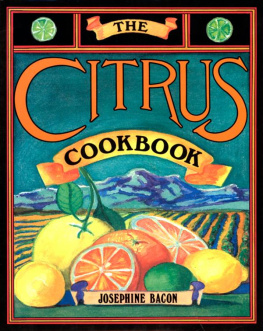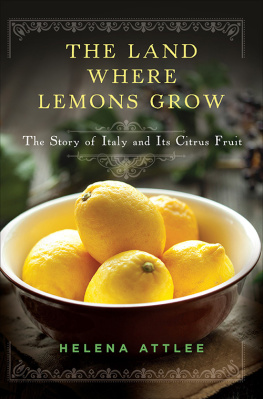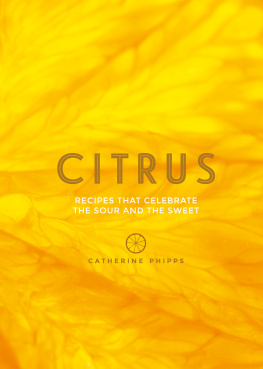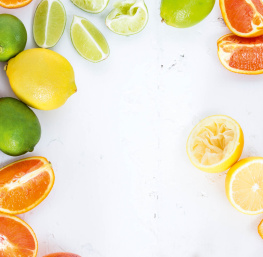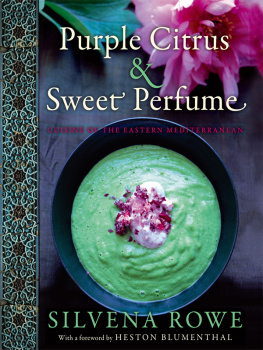The Harvard Common Press
535 Albany Street
Boston, Massachusetts 02118
Copyright 1983 by The Harvard Common Press, Inc.
All rights reserved. No part of this publication may be reproduced or transmitted in any form or by any means, electronic or mechanical, including photocopy, recording, or any information storage or retrieval system, without permission in writing from the publisher.
Printed in the United States of America
Library of Congress Cataloging in Publication Data
Bacon, Josephine.
The citrus cookbook.
Bibliography: p.
Includes index.
1. Cookery (Citrus fruits) I. Title.
TX813.C5B33 1983 641.6'435 83-10851
ISBN 0-916782-43-3
ISBN 0-916782-42-5 (pbk.)
Illustrations and cover design by Nancy Simonds
10 9 8 7 6 5 4 3 2 1
ISBN 0-916782-43-3 HC
ISBN 0-916782-42-5 PB
To Bruce Johnson, who made it all possible
Acknowledgments
I would like to thank the following people for their help and encouragement, and above all, their patience with my endless questions: Lewis Robison, Editor, California Citrograph; Melissa Arnold, Council of California Growers; Professor Robert Soost, University of California, Riverside; Dr. Randy Keim, South Coast Field Station, Santa Ana, California; Cliff Wurfel, Special Collections Librarian, University of California at Riverside; and Pat Sawyer and Peggy Winter, California Rare Fruit Growers Association.
Introduction
Glorious, golden citrus fruits, set off against lush green foliage, have been cultivated as much for their beauty as for their delicious flavor and nutritional properties and the fragrance of their blossoms. Citrus is in full fruit and bloom, moreover, in the bleakest season of the year, when other flowering plants are leafless and dormant. Some citrus varietiesthe citron, for instancebear fruit and blossoms simultaneously, and will do so almost year-round.
These magical qualities have stimulated the cultivation and spread of citrus fruits since ancient times. Citrus varieties were among the earliest fruits to be imported to the Western world, and they became the first major crop to be cultivated away from their native soil.
They were also the first plants to be grown in a totally hostile climate. The orangeries, conservatories, and other sheltered environments originally devised to protect these beautiful trees from the ravages of a northern winter eventually provided the means to cultivate other useful tropical plants.
The technology originally developed so the rich could grow oranges and lemons in their own gardens led not merely to the production of other unseasonable fruits and flowers for the delectation of the wealthy, but to the transplanting of valuable cash crops from one part of the world to another. Eventually, all kinds of edible and useful plants became available for consumption worldwide. The techniques first used for transporting and transplanting citrus fruits were used to bring rubber plants from the Brazilian jungle to Malaya, coffee from Ethiopia to South America, and cocoa beans from Mexico to West Africa, thus changing the face of world agriculture.
Strangely, citrus fruit production is greatest outside the regions where the plants grow wild. The main areas of citrus cultivation today are the United States, southern Europe (Spain, Italy, Greece), North Africa, the Middle East, Australia, and South Africa. Of these, only Australia has native citrus varieties, but they are not suitable for commercial cultivation.
Citrus fruits have played key roles in both Eastern and Western cultures. They have become religious and folkloric symbols of wealth, happiness, and fertility. Their beauty has been extolled by great writers and depicted by famous painters. They are the "golden apples" of myth and legend.
The discovery of the nutritional value of citrus fruits has brought about the mass cultivation of oranges, lemons, limes, grapefruit, and tangerines. Other citrus plants are grown for the fragrance of the fruit (the citron) or the blossom (the bergamot orange). The essential oils in citrus rind are used in perfumery and polishes.
There are so many aspects to the story of citrus fruits and their cultivation that it would be impossible to cover them all in the space available here. If you want to know more about citrus than you can find in this book, consult the bibliography for guidance in further reading.
ABOUT THE RECIPES
Since citrus fruits have become an integral part of the human diet, both in and out of the citrus-growing regions, the recipes in this book are drawn from every corner of the world. I have included, besides the classic citrus recipes, as many national dishes as I am aware of. I have specified the origin of a recipe where it may be of particular interest.
Since I am not fond of overelaborate creations, most of the dishes are, I hope, simple and fairly quick to prepare. The only exceptions are the candied fruits, which take time and trouble. But candying is more of a hobby than a culinary necessity, and there is no way to speed up the process. Nor have I wasted valuable space by explaining how to fashion citrus fruit into flower shapes, baskets, and so on. For those who are interested, much literature on this subject is available for free from citrus marketing organizations.
Because people who grow the more unusual varieties of citrus in their gardens or indoors are continually asking me about ways to use them, I have included hard-to-find recipes for these unusual fruits. My apologies to those who cannot lay hands on a citron or a calamondin, and who will thus find these recipes of little use. But because citrus growers are constantly developing new commercial varieties to tempt the shopper, you may find that today's rarity becomes tomorrow's new fad. The pomelo, for instance, has become a popular fruit again in northern Europe since Agrexco, the Israeli citrus marketing board, began promoting it. So do not fret, your supply of citrons and calamondins may be arriving in the corner store tomorrow!
I have included recipes using citrus products, such as orange flower water and candied peels, most of which are imported. Orange flower water is produced mainly in France and Lebanon, and candied peel is imported from South Africa, Australia, and South America. These products are easily available at good delicatessens and gourmet food shops, and are sometimes to be found in farmers' markets and even supermarkets, particularly around Christmastime.
I have tried to avoid the obvious, so I make no reference to the various juicers, squeezers, graters, and other gadgets that the reader can use or not, as he or she prefers. I am told that the best French chefs use nothing but their bare hands to squeeze oranges and lemons. My own grip is not firm enough, so I use a squeezer.
All of the recipes calling for citrus juice have been written with the fresh-squeezed variety in mind. Even food scientists are forced to admit that they are unable to reproduce the true citrus flavor in reconstituted and preserved juices. This is particularly true in the case of lime juice, which has a fragrance all its own. Furthermore, "pure" canned, freeze-dried, or concentrated citrus juiceeven if it has added vitamin Clacks the nutrients and trace minerals of fresh citrus. You can use preserved juice if you like, but there is no real substitute for the fresh fruit.
When you squeeze your own juice, likewise, you should use it immediately if you want to derive maximum nutritional benefit from it. Because vitamin C is a very volatile substance, most of this nutrient will be lost if you leave the juice overnight, even if you cover it. You can freeze citrus juice, but it will lose much of its nutritional value, just as the commercially-frozen product does.
Many of the recipes call for the fresh rind or peel of citrus fruits. Although it is supposed to be perfectly safe to eat dyed citrus peel, it is not recommended that you do so. Though Florida permits growers to dye their products, California, Arizona, and Texas do not, so you are absolutely safe with western citrus. There is no need to avoid citrus whose peel has a greenish tinge; regreening, as it is called, actually occurs after the peel has first turned orange. It does not affect the flavor of the fruit, and the peel is perfectly safe to eat (unlike green potato skins, which are poisonous). Grated peel, fresh or not, contains no vitamin C, since this important nutrient is destroyed even by cutting.
Next page
